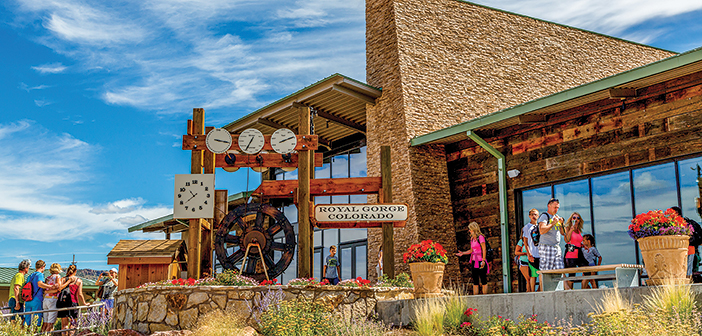The visitor center at an aerial adventure operation serves a variety of functions, many of which the visitor is never actually aware of. Before constructing a visitor center, or renovating an existing one, the importance of proper planning cannot be overstated—from the general layout to the exact locations of electrical outlets, and everything in between.
As the old carpenter’s rule says: measure twice, cut once. This applies to planning your visitor center. Here, we’ll provide some tips to help you get it right the first time, and help avoid finding costly and time-consuming mistakes after the project is done.
General Principles
Whether you are adapting an existing space, building from scratch, or utilizing a modular system, the basics are the same. Efficiently allocating space for each of the center’s several functions is essential. Those functions include guest reception, retail concession, restrooms, tour staging/gear up area, business office, staff lounge, gear storage, supply shelving, and bulk warehouse. The amount of space dedicated to each area depends on the volume of traffic expected at peak periods.
If all of the functions can be under one roof, the expense is generally less than having multiple structures. Even more cost efficiencies are realized if the facility has multiple levels. The following advice assumes a multi-level facility with everything under one roof, but regardless of the structure, the same principles apply. You have to balance space allocation, traffic flow, system efficiency, participant comfort, asset protection, and staff considerations when planning your visitor center.

The visitor center at Anakeesta in Gatlinburg, Tenn., is inviting with an easy-to-navigate arrival experience.
Parking. While not part of the visitor center structure, having enough parking for peak periods is an important consideration because all space—land or structure—has a cost, so prudent use of space is critical. One formula estimates 2.5 guests per car. A three-hour attraction that can turn over three times per day averages 7-8 guests per parking space. If you anticipate a maximum of 200 guests per day, you’ll need a minimum of 30 guest parking spaces, plus spaces to meet ADA requirements.
In addition, you’ll need to accommodate staff vehicles either on site, or off site and shuttle them in.
Guest access. The visitor-center access should be inviting and easy to find. Here, traffic flow becomes a primary consideration. Upon entering, the check-in counter or kiosk where participants register, execute the waiver, and are weighed should be easily accessible, with plenty of space in front of or around it.
Once registered, guests will need an incentive to move on from the reception desk to reduce congestion. A fire pit, game area, short nature trail, observation deck, video wall, or point of interest should be planned to move the guest away from the check-in/out space.
Retail. The retail display area should be visible from the reception desk, but located where it doesn’t block guest flow or access to the other activities.
Restrooms. First, restrooms should be intelligently located. For example, if guests need to walk through the retail display to get to the restrooms, it increases exposure of the merchandise offered. Unisex or family-designated use reduces lines, and is also less expensive to build and maintain.
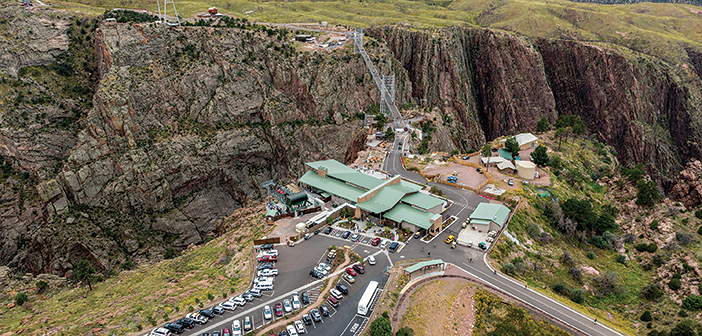
Don’t forget parking in your plans. Aerial view of Royal Gorge lot.
Tour prep area. The area where guests get harnesses and gear should be a designated quiet area away from crowds, so instructions can be heard and distractions kept to a minimum. Multiple stations may be necessary depending on the number of participants. Each station should have convenient access to the gear storage room to facilitate staging the gear pre-tour, and returning to storage at the completion of the activity. Ideally, both the guest access and the gear storage room are on the same floor of the building, preferably at ground level.
Make your gear-up space big enough for spectators to observe the process. Often, non-participants (think parents and grandparents) want to watch and hear the guide instructions/ground school.
Business office. If possible, the business office should have visibility and quick stairway access to the main floor, to react to situations requiring supervisor attention. The visibility requirement suggests this would be on the second floor or a mezzanine. Storage space for office supplies and other daily replenishment items should be a part of, or close to, the office.
Staff lounge. This space can be on the lower level, but should have separate outside access from that which the public uses. It should have enough space for seating, a table, and lockers or cubbies where staff can store their stuff. It should also have sufficient electrical and shelving for conveniences such as a refrigerator, microwave, and perhaps a hot plate. A sink is also helpful.
Bulk storage. You’re going to need a dry, accessible place to store the things that you may not need every day, but take up a fair amount of room. This area can be located on the lower floor.
Specific Needs and Considerations
Once space has been allocated, planning within that space is critical to efficiency.
Wiring and electronics. The reception area will house many systems requiring both space and wiring. Guest check-in and -out is usually performed in the same area, with the same staff utilizing the same equipment. Computers, credit card processors, Wi-Fi modems, telephone systems, cash drawers, electronic scales, printer, scanner, video player, and TV remotes along with supplies and other essential accessories will all be in an 8- to 12-foot counter or kiosk. Most will require wiring and electrical outlets.
The business office, staff lounge, and storage rooms will have their own specific wiring needs, with a security system, floor and wall outlets, interior and exterior lighting, HVAC requirements, and battery chargers. The location of the breaker box itself should be finalized prior to contacting an electrician for completion.
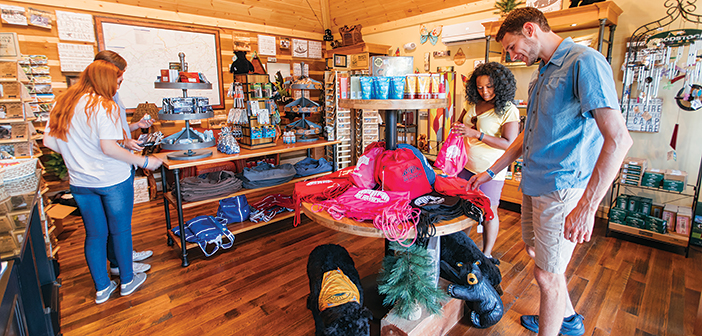
Great Outdoors Trading Company retail space at Anakeesta.
Retailing 101. At a minimum, the visitor center retail area should sell discretionary souvenirs such as t-shirts, photos, and logo items that help guests document and remember the experience. Sunscreen, sunglasses, bug spray, and other personal care items should be available, too, and merchandised close to the cash register.
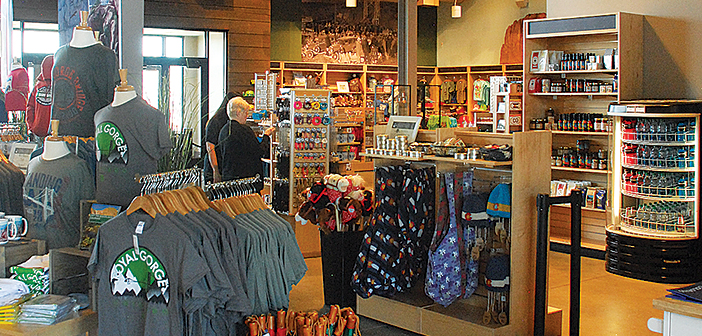
Retail space at Royal Gorge has souvenirs, snacks, and essentials.
Another merchandising tip: offer souvenirs that range in price, but put higher-priced items in prominent locations. Grandma is likely to buy something, so would you rather she buy a $2 keychain or a $40 hoodie? If grandma has a cheap and easy option, she may take it, so make it easier to decide on something of more value. Plan your assortment and placement of merchandise wisely.
Food service. The level of food service you offer requires some thought and analysis. Refreshments, both drinks and snacks, are expected. Packaged food, vending machines, drink and ice cream coolers can address the basic needs of your guests without complicating the situation.
If your facility already has dining with appropriate kitchen facilities, it’s a desirable amenity. If it does not, take a long, hard look before adding it. Do you want to add the health department to the other regulatory agencies you will be dealing with? In addition to the space needed for food service, consider the other requirements: refrigeration, sterilization, waste disposal, inventory management, and service format (table service, buffet, grab and go).

The dining area at Royal Gorge is large, scenic, and invites visitors to sit and take in the view.
For new operations, it’s prudent to delay that decision a year or two, or until experience dictates the direction you should take. If the core business is adventure, stick to the knitting until you are confident food and beverage service will be successful.
Brown bagging. Guests may also bring their own food and beverages, and use a picnic area if there is one. If you offer only basic snacks and drinks, you can always encourage guests to bring their own sandwiches, etc.
Determine a policy on alcoholic beverages. First, check with local and state authorities to see if there are rules you must adhere to, even if you aren’t serving/selling alcohol. Of course, the number one rule for participants is no consumption prior to or during participation. If state and local rules allow, it’s up to you if alcohol is permissible for non-participating guests and guests who have completed the activity. Limiting alcoholic beverages to a designated area makes sense, whatever your policy.
Climate control. Another consideration for the public areas is climate control. The more open the public area, the better. If the interior is more comfortable than the exterior, no one will go outside, and the reception area will be jammed. The office staff may discreetly use fans and heaters as needed and dress for the season.
Restrooms. Restrooms are most versatile when limited to one commode, sink, mirror, wastebasket, air freshener, coat hooks, ceiling light with exhaust fan, soap, and towel dispenser. The floor should be an easily cleaned artificial surface, no wood floors. Decorate the walls with photos of the park, but no people. Privacy locks on the inside of the door. Inspect frequently for cleanliness and to replace supplies.
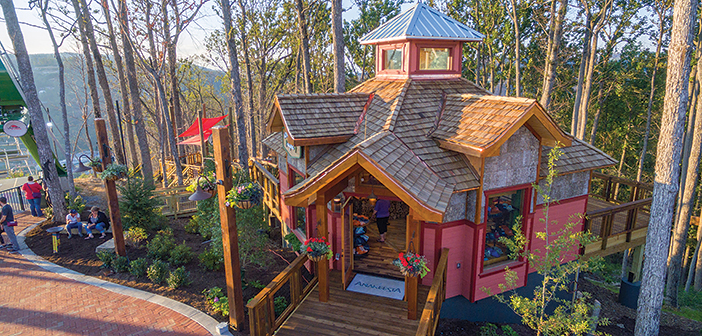
The Adventure Outpost at Anakeesta is the launch pad for many activities.
Gear room. The gear room should be adjacent to the prep station. Trolleys, harnesses, and other gear must be stored in a way that rotates the use. Well-anchored cables strong enough to support the considerable weight of the gear are a good method. One system that works well: Returned gear is hung at one end of the cable, and current gear is retrieved from the other end.
A dehumidifying system is needed in the gear room to dry out sanitized gear. Store ropes and other such materials in rodent-proof containers.
Office, staff needs. The business office requires a lockable file cabinet big enough to store personnel files and other important documents. Two desks with chairs are essential. One will serve as the primary workstation, with phone and computer for reservations, payroll reporting, schedule production, record retention, etc. The second desk may be used for a variety of things. One or two walls should be shelved for supply storage.
The staff lounge should be properly stocked. It may have a microwave, refrigerator, hot plate, hot-water dispenser, and table with chairs for a quick lunch. Lockers would be nice, but cubbyholes more likely. The lounge is a potential morale disaster, with some appreciating it while others abuse it. Management should monitor daily.
Bulk storage and seasonal decorations will require dry space wherever it can be found. If vehicles are used, a barn or garage will prolong their useful life. Fuel storage can be in the same location.
George Powell always welcomes questions and comments. Direct them to [email protected].


